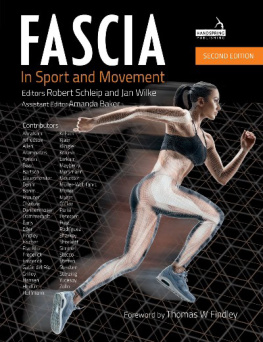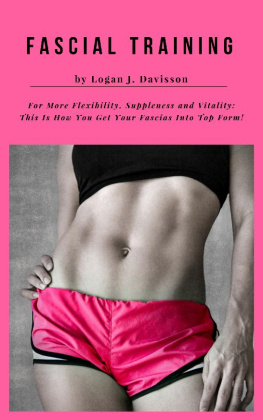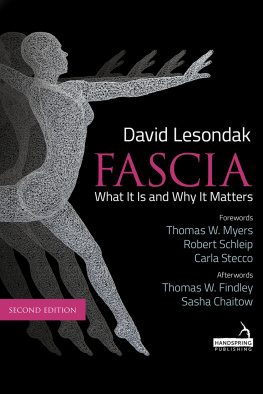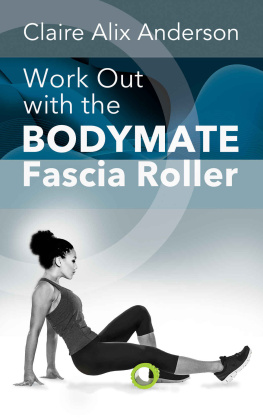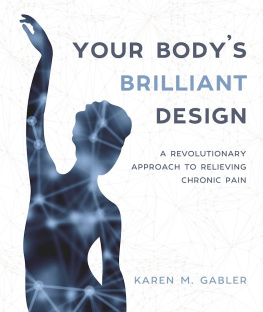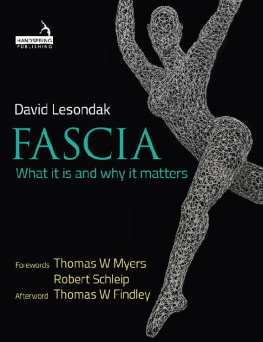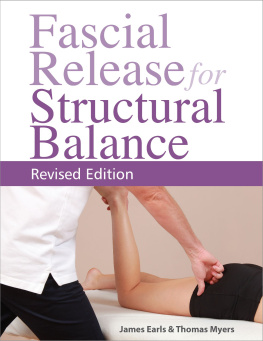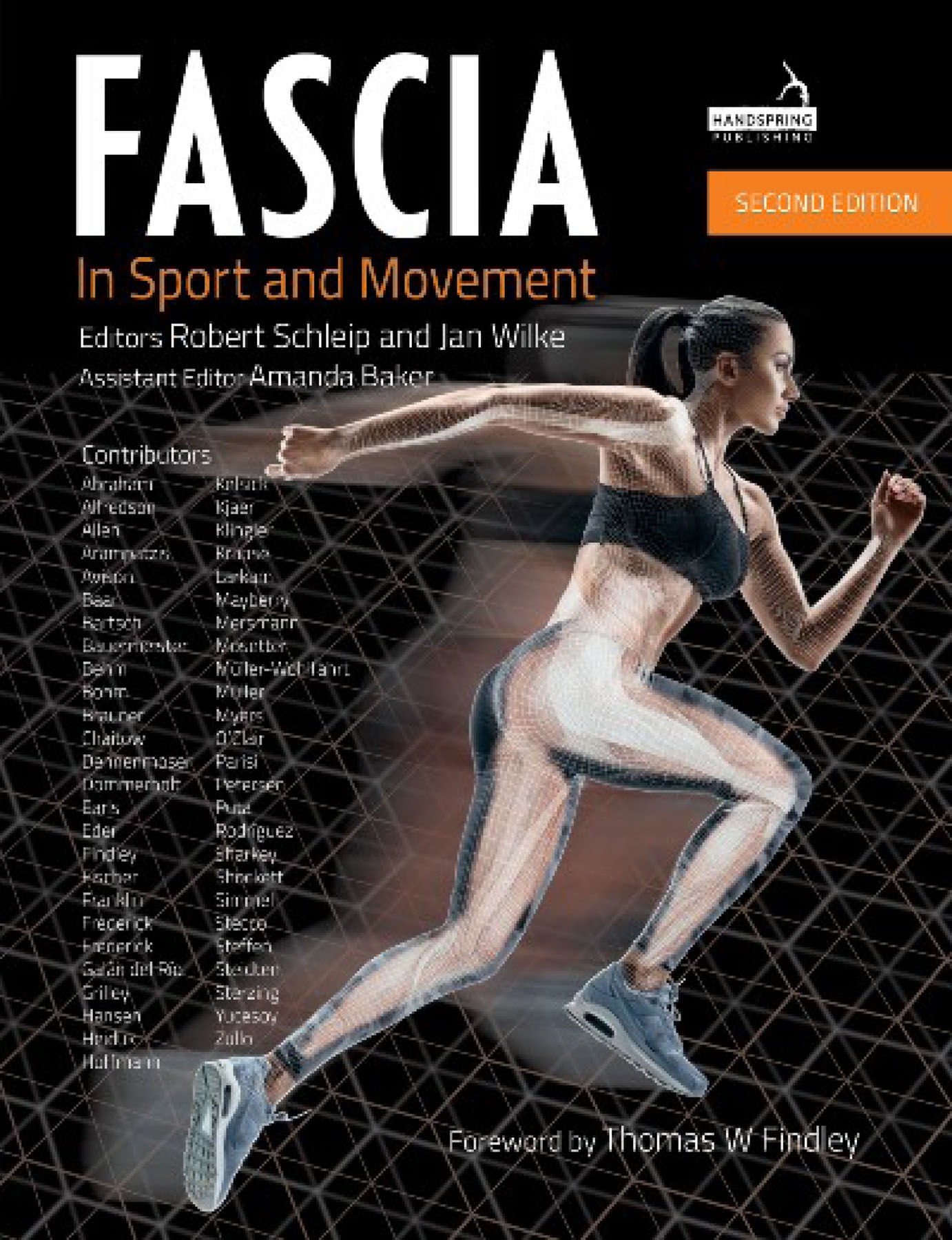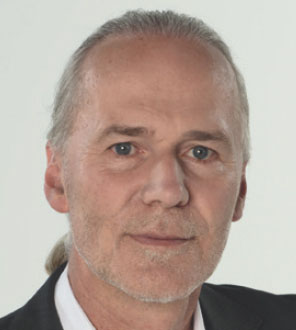Contents
Guide
Page List
HANDSPRING PUBLISHING LIMITED
The Old Manse, Fountainhall,
Pencaitland, East Lothian
EH34 5EY, United Kingdom
Tel: +44 1875 341 859
Website: www.handspringpublishing.com
First published 2021 in the United Kingdom by Handspring Publishing
First edition published 2013 in the United Kingdom by Handspring Publishing
Second edition published 2021 in the United Kingdom by Handspring Publishing
Copyright Handspring Publishing Ltd 2021
All rights reserved. No parts of this publication may be reproduced or transmitted in any form or by any means, electronic or mechanical, including photocopying, recording, or any information storage and retrieval system, without either the prior written permission of the authors and publisher or a license permitting restricted copying in the United Kingdom issued by the Copyright Licensing Agency Ltd, Saffron House, 6-10 Kirby Street, London EC1N 8TS.
The rights of Robert Schleip and Jan Wilke to be identified as the Editors of this text have been asserted in accordance with the Copyright, Designs and Patents Acts 1988
ISBN 978-1-912085-77-4
ISBN (Kindle ebook) 978-1-912085-78-1
British Library Cataloguing in Publication Data
A catalogue record for this book is available from the British Library
Library of Congress Cataloguing in Publication Data
A catalog record for this book is available from the Library of Congress
Notice
Neither the Publisher nor the Author assumes any responsibility for any loss or injury and/or damage to persons or property arising out of or relating to any use of the material contained in this book. It is the responsibility of the treating practitioner, relying on independent expertise and knowledge of the patient, to determine the best treatment and method of application for the patient.
All reasonable efforts have been made to obtain copyright clearance for illustrations in the book for which the authors or publishers do not own the rights. If you believe that one of your illustrations has been used without such clearance please contact the publishers and we will ensure that appropriate credit is given in the next reprint.
Commissioning Editor Sarena Wolfaard
Project Manager Morven Dean
Copy Editor Dylan Hamilton
Cover and Design Direction Bruce Hogarth
Indexer Aptara, India
Typesetter DiTech Process Solutions, India
Printer Findr, Czech Republic
The
Publishers
policy is to use
paper manufactured
from sustainable forests
CONTENTS
Robert Schleip directs the Fascia Research Project at Ulm University, Germany, and is Research Director of the European Rolfing Association. He is a certified Rolfing Instructor and Feldenkrais teacher. He is the author and co-editor of several books and has written numerous research articles. For his laboratory research work on active contractile properties in fascial tissues he was awarded the Vladimir Janda Award for Musculoskeletal Medicine. He was the co-initiator and organizer of the inaugural Fascia Research Congress (Boston, 2007) as well as all subsequent congresses.

Jan Wilke leads the Fascia in Motion research group at Frankfurt University, Germany. He is a member of the American College of Sports Medicine, and has been invited as a Visiting Fellow by Amsterdam University (the Netherlands) and Liverpool University (the UK). His chapter on Myofascial Chains, published in Grays Anatomy, represents one of the first anatomical atlas contributions explicitly focusing on fascia and movement. In addition to his academic tasks, Wilke is a conditioning coach and has worked with high-level athletes, including the former world No. 1 tennis player, Angelique Kerber.
Amanda Baker is an experienced yoga teacher and Pilates instructor working in a clinical practice. After completing her Masters degree, she became a freelance journalist in the health and fitness industry, and then qualified as a Fascial Fitness Trainer.
Dr Amit Abraham (PhD, MAPhty, BPT) is a musculoskeletal physical therapist specializing in dance and sport injuries and mental imagery for dancers, athletes, and people with Parkinson disease. He is an Assistant Professor in the Department of Physical Therapy, Faculty of Health Sciences at Ariel University (Israel). Dr Abraham holds a Bachelor in Physical Therapy from Tel-Aviv University (Israel), a Masters Degree in Musculoskeletal Physical Therapy from The University of Queensland (Australia), and a PhD in Physical Therapy from the University of Haifa (Israel). He completed his post-doctoral training at Emory University School of Medicine (Atlanta, USA).
Professor Hkan Alfredson (MD, PhD) is a research specialist in the field of chronic painful Achilles and patellar tendon and cartilage repair. He has published more than 150 articles in peer-reviewed scientific journals. He currently works at the Alfredson Tendon Clinic (Sweden), for Pure Sports Medicine (UK), and at the Sports Medicine Unit, University of Ume (Sweden).
Johnathon Allen is a writer/photographer and co-author of Fascia Training: A Whole-System Approach. His work has appeared in Bicycling, Outside, Adventure Journal, Decline, and other publications. He is also author of the nonfiction books Rays and Doppelganger Effect.
Professor Adamantios Arampatzis is Head of the Department of Training and Movement Sciences, and is Spokesperson of the Berlin School of Movement Science. His research deals with the interaction of the central nervous and peripheral systems, and how these systems develop over the lifespan and adapt to changing environmental demands.
Joanne Avison (MSS) is an advanced Yoga Teacher, Yoga Therapist (C-IAYT) and Structural Integration practitioner/teacher. Her fascination with fascia and human architecture led her to becoming a founding member of the Biotensegrity Interest Group, pioneering the application of biotensegrity for movement and manual practitioners. She is also the author of YOGA: Fascia, Anatomy and Movement (Handspring, 2015).
Professor Keith Baar (PhD) is a molecular exercise physiologist with a specific interest in the molecular response of the musculoskeletal system to nutrition and loading as a function of age. The Baar lab uses a series of complex animal and human models and has also developed unique 2- and 3-dimensional tissue culture assays that can be used to study the effects of genes and nutrients on muscle and tendon/ligament function. Using these models, the Baar lab performs translational research on the molecular signals that underly musculoskeletal function and how these signals are affected by age, diet, and exercise. Prof Baar collaborates closely with clinical partners at UC Davis and around the world. At UC Davis, Prof Baar works with clinicians at the School of Medicine and the School of Veterinary Medicine to optimize musculoskeletal health and performance. Three primary avenues of research are actively pursued: 1) The molecular determinants of muscle size and strength; 2) Optimizing exercise and nutrition for tendon/ligament function; and 3) Determining the role of the musculoskeletal system in the neurocognitive benefits of a ketogenic diet. Because of the applied nature of Prof Baars work, he has worked with elite athletes, as a scientific advisor to the numerous professional and Olympic organizations. His work with these organizations is designed to maximize the effects of training for both endurance and strength while minimizing injury.

